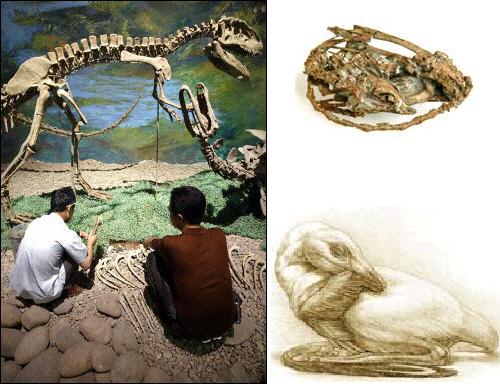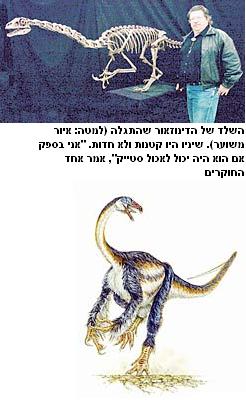"The specific posture of maintaining body heat, in which 'Mei Long' was found, supports the hypothesis that at least some non-flying dinosaurs, including this animal, were warm-blooded like today's birds"

The first ever fossil of a dormant dinosaur has been discovered by paleontologists in China. The 130-million-year-old find was called "Mei Long", which means "sleeping dragon" in Chinese.
The find, which was reported in the latest issue of the journal "Nature", was discovered in the fossil-rich fields of Liaoning Province in northeastern China. The 60-centimeter-long dinosaur was in its final stages of puberty and appeared to be sleeping or resting lying on the ground when it was buried under a landslide. That's why it was so well preserved.
In the report, the paleontologists described the posture of the dinosaur, which looked almost as if it were alive. The creature sits on long, folded back legs. His forelimbs are folded like a bird's legs next to his body and his small head rests between the left elbow and the body, in a manner almost identical to the position in which modern birds sleep, with their heads under the wing. Birds do this to conserve body heat.
"The specific position of maintaining body heat, in which 'Mei Long' was found, supports the hypothesis that at least some non-flying dinosaurs, including this animal, were warm-blooded like today's birds," concluded the authors of the study, Dr. Xing Xu from the Institute of Paleontology of Vertebrates in Beijing and Dr. Mark Norrell from the American Science Museum in New York. The researchers said this provides further support for the evolutionary link between the extinct dinosaurs and modern birds.
Courtesy of Walla.
A species of dinosaur was discovered, which was in the midst of transitioning from eating meat to vegetarianism
The other animals around breathed a sigh of relief
18.5.2005
From: News and Walla!

Paleontologists from the University of Utah announced last week the discovery of an unknown species of dinosaur that was in the midst of transitioning from meat-eating to vegetarianism. The researchers can only speculate what the reasons for the change were, but they noted that it took place at a time when the temperatures on Earth rose and the amount of plants increased.
One of the researchers, Dr. James Kirkland, said that the new species, given the name Falcarius eutensis, was discovered two years ago near the city of Green River in Utah. The length of the dinosaur was about four meters and its height was about 130 centimeters. It belongs to a group of ancient feathered dinosaurs called Tyrannosaurus. When the researchers examined the characteristics of the fossils found, they discovered the "beginnings of characters characteristic of herbivorous dinosaurs": the teeth were small and adapted to chewing leaves, very different from the sharp, blade-like teeth typical of carnivores. "I doubt that this dinosaur could have eaten a steak," said Dr. Kirkland. The researchers described and analyzed their findings in an extensive report published last week in the journal "Nature".
According to Scott Sampson, Chief Curator of the Natural History Museum at the University of Utah, Falkarius is "an example of evolution in action - a primitive dinosaur that has much in common with its carnivorous relatives, but many features that indicate it was in the process of becoming a vegetarian animal, which is at a more advanced stage in evolution." of the dinosaurs".
Lindsay Zano, a doctoral student in paleontology at the University of Utah, said Falkarius was "the earliest known therizinosaur, proving that this group of large, herbivorous dinosaurs descended from carnivorous dinosaurs like the fast and ferocious Velociraptor." Plecarius and Velociraptor share a common ancestor.
The researchers don't know for sure what Pelcarius ate - meat, plants or both - and they speculate that the process of turning the mad dinosaur into a vegetarian lasted several million years. Either way, "we have actual fossil evidence for a major change in diet," said Dr. Sampson. "This is surely the best example of this in dinosaurs."

One response
How many dinosaurs have flagged so far
?